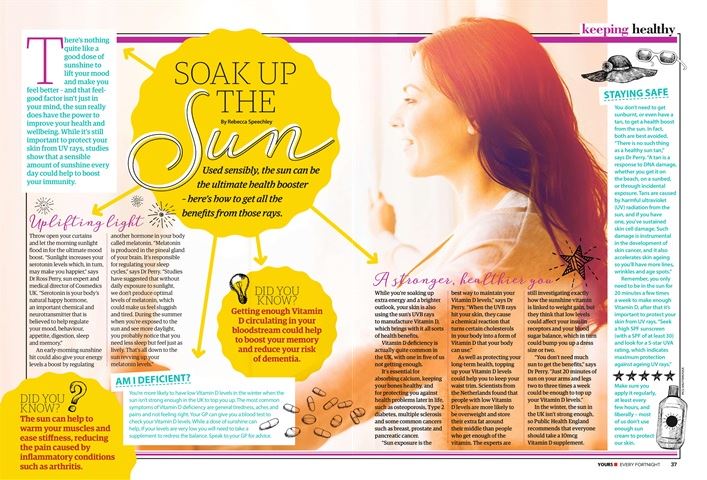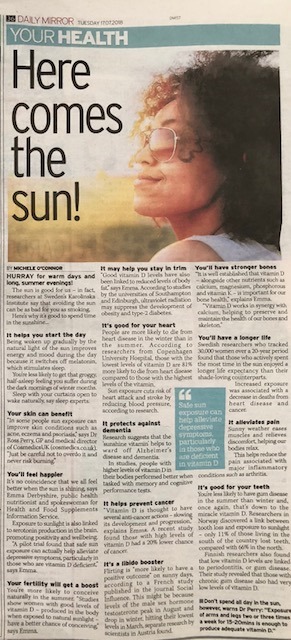Yours magazine looked at the health benefits of the sun, with expert advice from Dr Ross Perry.
One of the principle benefits of sitting in the sun is that it simply makes you feel good. Ross says:
“Sunlight increases your serotonin levels which in turn may make you happier. Serotonin is your body’s natural happy hormone, an important chemical and neurotransmitter that is believed to help regulate your mood, behaviour, appetite, digestion, sleep and memory.”
The Sun and Sleep Patterns
It could also help regulate your sleep:
“Melatonin is produced in the pineal gland of your brain. It’s responsible for regulating your sleep cycles. Studies have suggested that without daily exposure to sunlight, we don’t product optimal levels of melatonin, which could make us feel sluggish and tired. During the summer when you’re exposed to the sun and see more daylight, you probably notice that you need less sleep but feel just as lively. That’s all down to the sun revving up your melatonin levels.”
Vitamin D
Around 1 in 5 Brits don’t get enough vitamin D, which is essential for absorbing calcium. Dr Perry says:
“Sun exposure is the best way to maintain your vitamin D levels. When UVB rays hit your skin, they cause a chemical reaction that turns certain cholesterols in your body into a form of Vitamin D that your body can use.
Having low Vitamin D is not an excuse to sit in the sun all day. Dr Perry says:
“You don’t need much sun to get the benefits. Just 20 minutes of sun on your arms and legs 203 times a week could be enough to top up your vitamin D levels.”
In the winter, the sun in the UK isn’t strong enough, so Public Health England recommend a Vitamin D supplement.
Safe Sun Exposure
While there are benefits to sun exposure, there are also risks to be aware of. Dr Perry warns:
“There is no such thing as a healthy sun tan. A tan is a response to DNA damage whether you get it on the beach, on a sunbed or through incidental exposure. Tans are caused by harmful ultraviolet (UV) radiation from the sun and if you have one, you’ve sustained skin cell damage. Such damage is instrumental in the development of skin cancer and it also accelerates skin ageing so you’ll have more lines, wrinkles and age spots.
“Seek a high SPF sunscreen (with a SPF of at least 30) and look for a 5-star UVA rating, which indicates maximum protection against UV rays.”

Private Mole Checks & Removal
The London Mole Removal Centre is a private company which is best known for mole removal. The team of dotors and surgeons offer mole checks and treatment for unwanted moles and other skin lesions (cysts, skin tags, warts, verruca, lipoma etc) at 5 mole removal clinics in London and Bristol.
London Mole Removal Centre also offers:
- Private treatment in comfortable surroundings
- No waiting lists for fast treatment
- Moles can often be removed in the same appointment as the consultation
- Clinics in London and also Bristol
- Removed moles tested with report provided
For more information or to book a consultation, please complete the form on this web page or call 020 7731 3791.

 The feature entitled “13 reasons why spending time in the sunshine is good for your health” gives 13 ways in which the sun can be beneficial for health including some surprising insights from scientific research from around the world:
The feature entitled “13 reasons why spending time in the sunshine is good for your health” gives 13 ways in which the sun can be beneficial for health including some surprising insights from scientific research from around the world: